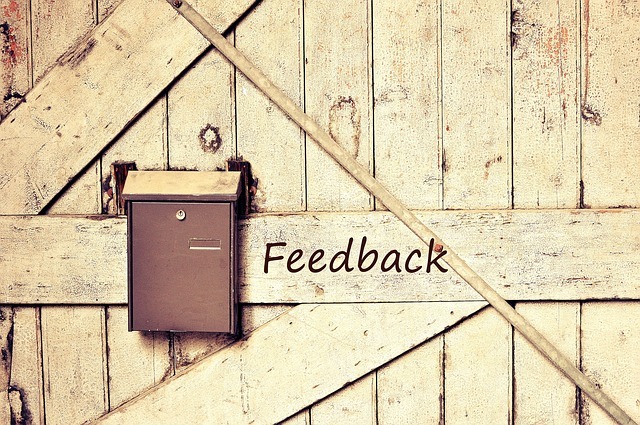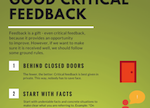Providing timely feedback is one of the most important management tasks. Without feedback, we do not know if we are meeting the expectations of those around us, and it is harder to grow personally and professionally. In an ideal organization, every employee not only receives feedback about her performance, but also regularly gives feedback to several people.

The widespread 360 degree method, where feedback is received from many peers, superiors, and subordinates, is a systematic way to provide everybody in the organization with feedback. Usually, this is done anonymously. The reasoning behind it is that anonymity will help people to provide honest feedback, unbiased by political considerations, and without fear of negative consequences. In order to keep the feedback process from degrading into a destructive ranting spree, questions are usually put more like “What can Peter do better?” rather than “Where does Peter suck badly?”.
Problems of anonymity
Still, receiving critical anonymous feedback from potentially several dozens of people can feel overwhelmingly depressing, because of several reasons:
- The mere fact that you don’t know exactly where the feedback comes from makes you feel a bit powerless. You don’t know if a negative comment comes from somebody sitting right next to you, or from somebody you interact with only once a month. Moreover, you have no way to defend yourself.
- Written communication frequently leaves a lot of room for misunderstanding, and is often received as harsher than it would be in a face-to-face conversation. This is not just a problem with feedback comments, but also with emails, chats, and comments in an issue tracker or in code reviews. However, if the feedback is anonymous, you cannot ask the feedback giver to clarify, or provide her some context that she might be missing.
- If the feedback giver refers to a situation that is not very recent, the receiver of the feedback might not remember it very well. This can, again, lead to poor understanding, and to ineffectiveness.
- There is the general problem that we tend to read over positive feedback quickly and then forget about it, but really take the negative feedback in and chew it over for days and weeks. Anonymity does not help here, since, additionally, you have to wonder where the critical feedback comes from.
I feel that in an ideal organization, anonymous feedback should not be necessary. If a feedback receiver is self-reflective, able to deal with criticism, and appreciative of feedback even if it is not pleasant, and if furthermore the person giving the feedback is respectful and has the other person’s best interest at heart while being honest and sticking to facts, then hooray! Feedback will be given frequently and contribute to the development of each employee as well as to the health of the entire organization.
Does anonymity equal broken culture?
Some managers (beware of paywall) even go so far to say: “If you have to use the channel of anonymity to get ‘real feedback’ then you quite clearly have a much, much bigger problem in your feedback culture.”
I’m not sure that the feedback culture must be considered broken if you use anonymity at all, but the author makes another interesting point. In his opinion, feedback, by definition, is supposed to be uncomfortable. Thus, if we use anonymity to get around that, we sacrifice a lot of the value that feedback should bring.
I feel there is some truth in this statement. If feedback is not at least a little bit uncomfortable, then it is very easy to shake it off (sorry, I just had to) and forget about it quickly. No thinking process is triggered, your self-reflection is not activated, and you will make no changes to your attitude or behaviour. As an aside, the same is true for apologies: An apology should cost you some effort, or otherwise you might as well leave it.
The other extreme: Ad-hoc and transparent
Having considered 360s, which are infrequent and (I believe) mostly anonymous, let’s look at the other extreme. The folks at Buffer, with their principle of transparency, took the idea of open feedback a step too far for some time. They used a tool called Small Improvements through which anyone could share ad-hoc feedback. However, apart from the feedback receiver seeing her feedback along with who was giving it, so did everybody else. In other words, the entire company could see what feedback people gave to whom, including the entire feedback history.
According to Leo Widrich, one of the Buffer founders, this setup had three negative effects:
- Very few people gave any transparent feedback at all.
- Any time critical feedback was given, it turned into a big thing.
- It was hard to save face and easy to be defensive.
This was certainly not the outcome the Buffer management had hoped for, so, after some time, they switched back to making feedback private again. However, feedback at Buffer is still attributed, i.e., non-anonymous, because people usually just use email, chat, or video calls. This direct communication ensures that clarifying discussions can follow the initial act of giving feedback. Attributed feedback can thus be viewed as a middle path between anonymous feedback and totally transparent feedback.
Attributed, but not public
At least in theory, attributed feedback has a couple of advantages compared to anonymous feedback:
- With attributed feedback, feedback givers arguably put more thought into what they write, and will be more constructive, because they know that the person they give the feedback to might ask them to have a chat about it later. This makes inconsiderate comments like “I hate the way he always acts like he’s the greatest” less likely.
- Because the feedback giver is known, the feedback receiver can go and talk to her, so that a dialogue can develop, and different points of view can be sorted out.
What about disadvantages of attributed feedback? Well, some feedback might be simply not given at all, out of fear of bad consequences. This applies especially to persons in positions of power. Patrick Lencioni tells a hilarious (but actually sad) story (skip forward to about 7:00) about a CEO who was brilliant and intimidating, but whose leadership style had some severe flaws, and nobody on the executive team dared to give him honest, critical feedback. So they did an anonymous 360, and the CEO, in a staff meeting with exactly the people who had given the anonymous feedback, went over the results with them.
Guess what? Nobody was ready to confirm, comment or elaborate on the criticism they had given anonymously. “No, that’s not true, I think you’re doing great.” - “Yeah, me too!” - “Yeah, I don’t have a problem with your way of delegating!” And so on.
Attributed 360 degree feedback
But I think the effect of getting less feedback would show not just with people in higher-up positions, but even with peers. Most people do not enjoy giving critical feedback, so they welcome the safety of anonymous 360s to “say what they had kind of always wanted to say” but never found a good opportunity for, or never considered really important, but what still keeps bugging them somewhat.
Now, if people knew that their name will appear next to their comment for the receiver of the feedback to read, this might be a bit awkward. The feedback receiver could become upset, and maybe rightly so: “Aha, so all that time she never said a word, and now suddenly she doesn’t like my little pranks any more?” The person giving the feedback feels that she should have spoken up face to face at some point, instead of putting her criticism in the 360 degree software system, where it will now remain until the end of time. Consequentially, she might not put it down after all, but delay the feedback again - indefinitely, in some cases.
If there is an open culture where regular feedback is the norm, attributed 360s can work, I think. But people have to be really used to giving and receiving feedback more often than once or twice a year. This article describes an interesting variation of 360 degree feedback process, in that upward and peer feedback is anonymous, but all manager comments are attributable.
Know when to turn a deaf ear
So what’s the conclusion here? Attributed or anonymous? Personally, I was hoping that writing this article would give me clarity, but I think there is no right answer that fits for all situations and organizations. Most importantly, feedback should be given regularly instead of once a year. This ad-hoc feedback should preferably be direct, i.e., attributable. Giving and soliciting regular feedback has to be lived and encouraged from the top down if you want to grow a robust feedback culture.
If such a culture is in place, then there will be few surprises in end-of-year 360s, should they still be wanted or needed. In most cases, managers should be open to the idea of anonymous feedback from their reports, simply because the power difference can scare people off.
However, if you are in a leadership or management position, you will not be able to make everybody happy all the time. If, during the once-a-year 360 degree feedback period, you find yourself drowning in a flood of out-of-context feedback, then it is important to use your sanity check filter. There might be feedback that just does not reflect reality, is based on unrealistic expectations, or is an outlier. Identify these kinds of feedback (get help from somebody who knows you well and who you trust) and discard them. “You don’t have to react to everything” is what this HBR article advises us.
Great one-on-ones can be part of a solid feedback culture, but most people, if at all, have 1:1s only with their direct superior. If ad-hoc feedback is only ever given during 1:1s, this means that the direct superior becomes a feedback bottleneck. Therefore, a healthy feedback culture has to involve everybody, not just managers and team leads.
Time investment
This blog post took me about 7 hours of work, most of it for writing and thinking, but some also for research. As usually, most of it happened on the lovely S8 commuter train between Mönchengladbach and Düsseldorf.
Want to learn more about giving good feedback? Check this out:

Yours free: Info Poster on Giving Good Critical Feedback!
Learn how to give better critical feedback in 7 steps. This is a PDF that you can also print out and put on your office wall for other people to learn from. Just enter your email address here, and I will send you the download link. No spam ever, guaranteed.
 I'm Tom Bartel, Germany-based software developer, engineering manager, speaker, and human communication geek. More
I'm Tom Bartel, Germany-based software developer, engineering manager, speaker, and human communication geek. More